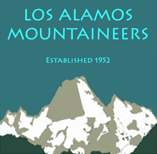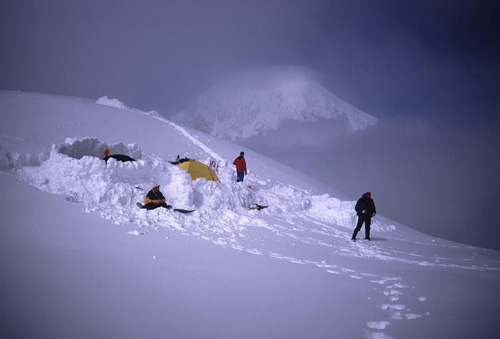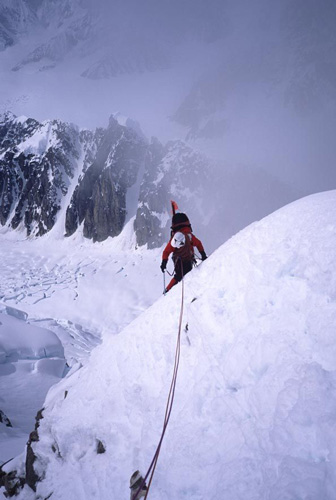| . | ||||||||||||||||||||
6/4/-15/2000 Gary Clark Participants: Gary & Lynn Clark (Los Alamos), Rich Strang (Santa Fe), Rick Whipple (Denver) Mt. Hunter Attempt II Slideshow: click here. This is the third year in a row we've had this route in our sights. In May of 1998 we cancelled the trip on the day we were to leave after seeing the weather reports for continued heavy storm activity in the area. In May of 1999 we went, we saw, we had good weather, but snow conditions were so poor as to make climbing all but impossible. We decided to give it one more shot in 2000, fully realizing that the problems we had encountered to date are the very reasons the route has had only a handful of successful ascents, and none at all since the early 1990s. We planned for a slightly later departure from New Mexico, hoping we'd still have good weather and also snow conditions more typical of later season - consolidated nevé and ice rather than bottomless powder.
Unloading on Thunder Glacier. We flew to the Thunder Glacier late in the evening of June 4, only about 24 hours after leaving New Mexico. We set up our tents for a couple hours sleep, then began climbing at midnight. Light is not a problem at these latitudes in June, so the safest time to climb is the coldest - right through the heart of the "night." The initial couloir is 2500' of some of the most dangerous terrain imaginable - perfect avalanche angle for it's complete length, with unstable rock walls above. Our strategy worked well, as there had been no recent snow, and we topped out in only about 4.5hrs; a big improvement over the 1999 effort when we were knee-deep in snow most of the way. The last bit of the couloir is the crux of the first day, and this year it was very tricky indeed. Steepening gradually to near vertical, the ice finally dwindles to bare rock. We had to climb 10' of 5th class rock with crampons, full expedition packs, and two ice tools hanging from our wrist loops. Overconfidence and momentum conspired to keep me moving through this section without placing any protection. As soon as I was over it, I realized that a fall would have been fatal for me and my ropemate. I quickly placed an ice screw and then a belay. Although we were still fresh and the day yet young, a rest was mandatory here at the 9600' col. We set up the tents and began melting snow. By the time we had re-hydrated and had some breakfast, a nap seemed in order, and then it was mid-morning. A blazing sun rendered foolhardy any plans of continuing on this day. We slept through the heat of the day, then started the exercise again in the wee hours of the morning of the 6th. The mandatory objective was camp II, another saddle on this long ridge at which every previous party has camped. Again we had hopes of shortening the climb by continuing past camp II, but the weather made the decision for us. As we started from camp I we could see major lenticular clouds over Mt. Foraker; it was only a matter of time before the storm hit. We had time to set up camp II and build a rudimentary protection wall before climbing in the tents for 48 hours of sensory deprivation. Our tent is only about a foot longer than I am. As the winds whipped the walls I felt like I was being hit on the head with a tennis racquet about every 10 seconds for the next two days. However, we were tired, and in some ways the rest was welcome. I was amazed to hear voices outside the tent late in the first storm day. We had been following the tracks of Dan and Nick from Seattle to this point. Dan had initiated an e-mail correspondence about his plans for the climb almost a year ago, so I knew on arrival that they would be starting up the route a day or two before us. It was good to finally meet Dan after scores of e-mails. He and Nick looked like apparitions in the howling blizzard; full down coats and ski goggles, all covered in rime ice. They had descended the very difficult third day of the climb in terrible weather. I got dressed and helped them reestablish their camp; just keeping the tent from blowing away while pitching it was a 2-person job. Their story came out; they had been on their summit push until the storm became imminent and unignorable. They turned around about 500' below the false summit, which is 1/2 mile and 800' short of the true summit. In good conditions the summit would have been a 4- or 5-hour round trip. It was a great effort, particularly for their first Alaska route attempt. We stayed at camp II for 3 full days; two of storm and one of clearing. Early the next morning we began the crux section of the route - a section of very steep mixed climbing, followed by a long knife-edge ice and snow ridge. The mixed section was tricky and dangerous. Rock protection was very scarce, and we'd often dig 3 or 4 deep pits in snow to reach a patch of ice for a screw placement. The need for speed was great as well, so Lynn and I simul-climbed the entire section, often with only a single point of protection per rope length. This is the kind of climbing that is not particularly difficult, just dangerous. Finally we were on the knife edge, and there were two bits of good news; first, Dan and Nick's tracks were largely intact, and second, they had already dug the pits to place ice screws and V-thread anchors, which would save us lots of time. We simul-climbed this entire section as well; about 8 rope lengths of 60-degree side slope below the knife edge. Conditions were about 18-24" of consolidated snow over extremely hard ice. However, coming up the final section to the ridge, I noticed the snow conditions deteriorating; where there had been nevé before, the top layer was now turning to powder. The threat of avalanche began to intrude on my mind.
Camp 3 Atop the knife-edge at last, we were now at the usual camp III. However, the place didn't quite match the description I had in my head, and there was no evidence that Dan and Nick had camped here. Although their tracks had disappeared, there were still wands leading up and around a steep slope, so I persevered, hoping to put in the highest camp possible to maximize our chances for the summit the next day. We skirted some overhanging seracs, then my heart sank as I looked at the next slope we'd have to negotiate. It was very steep; 50-60 degrees, but most importantly was completely unconsolidated. I moved up it about 10 feet, then called down to ask both rope teams to tie together and be ready for a team arrest. Below me I could see that the slope was concave, and ran out about a rope length below. Importantly, the rest of the team was still around the corner on stable ground, so nobody else was endangered by a potential slide. I continued up gingerly, plunging both axes deeply in front of me before taking each step. I didn't have to wait long. The slab broke nearly at the top of the slope and encompassed an area about 100' wide by 100' long. I was in nearly in the middle, and had the impression of crossing a river that was just a little too fast and deep. The entire event lasted about 8 seconds - the length of a bull-ride, and I would guess a similar adrenaline-producing experience, although I'm not dumb enough to ever try riding a bull, so I can't be sure. I was convinced twice during the 8 seconds that I was going along for the ride, but in the end was left standing where I started with a big pile of snow up my chest, spitting snow and unable to see because my glacier glasses were full of snow. My first thought was: "Great, that's over with, now I don't have to worry about it any more." I climbed on the now pristine layer of well consolidated snow toward the crest, noting with consternation that there were several large slabs still hanging, seemingly ready to go with just a touch since their support beneath was now gone. It was particularly unnerving climbing over the boundary where the slab had broken - although only about 8" deep, it seemed a nearly insurmountable obstacle psychologically. Finally on the crest I continued on all fours toward a small saddle visible above. My concern was now that my rope mates below would initiate further slides, and I'd have to hold the entire team on my axes. This was incredibly nerve-wracking. I dug a deep belay pit, a poor substitute for a real anchor but better than nothing, and brought the others up, a process that took about an hour. I had plenty of time to look around. The glacier where we had started was now about 6000' below. The entire southern half of the Alaska Range was spread out in front of me. There were steep drop-offs to both sides. In short it was one of the most spectacular spots I've ever found myself in, but I was not celebrating the spectacle. The stress of the previous couple of hours had done serious damage to my state of mind, especially since I could see that nearly all the terrain above us looked very similar to the slope I had just triggered. The upper slopes terminated in cliffs rather than a gentle runout. The others eventually arrived, I pronounced that we were in camp, and shortly indicated that I thought we might be at the high point of the expedition as well. We dug in and made dinner, and I began to relent, realizing that we wouldn't be able to live with ourselves if we didn't give it a go in the morning to evaluate the conditions. As Alex Lowe once said in a similar situation "There's no reason to conjecture about that which we cannot know." We set the alarm for 3:00a. When it rang I was not only not anxious to relinquish the warmth of my bag, but my stomach was feeling like it was headed for serious problems as well. I told Rick and Rich to go ahead; we'd follow if I started to feel better after a hot drink or two. We set the alarm for 5:00a, which would be responsibly early given that Lynn and I would have the advantage of their tracks, and we had only 1500' to go to reach the summit from this camp at 12,400'. The final slopes present only a few serious crevasse and bergschrund crossings in the way of technical difficulties; primarily they are just big, open, but steep snow slopes, the easiest terrain of the entire climb. At 5:00 we began to get dressed with substantial optimism. I didn't even have my boots on before we heard Rick and Rich outside the tent. They had made good initial progress up the knife-edge where we had our camp then on up the slopes to the first schrund, all on good snow. 50' above the schrund the leader began breaking through. After about 20' of unrelenting post-holing, he stopped to do a serious evaluation of the slope. Let's see . . . 50 degrees with a hard slab on top of 8" of depth hoar - this was a slope begging to be triggered, and the resulting avalanche would be mammoth and unsurvivable. Mark Twight had impressed me when he signed a book for me earlier this year. The inscription read: "To Gary - come back alive, come back friends, and bag the summit - in that order." We had adopted this as the guiding philosophy for our climb. Two out of three isn't bad.
Postscript: The descent in good conditions from a high camp has been done in a long day. Due to continued warm, sunny conditions leading to a rapidly deteriorating snow pack, we spent longer each day descending each section of the climb than we had spent in the ascent. Descent from high camp at 12,400' to camp II at 10,600' took almost 11 hours, most of which were spent sharing one set of 60-meter ropes on 4 rappels of the mixed section just above the col. We simulclimbed all but one of the ice pitches on the knife edge rather than rappel as other parties have reported; otherwise it would have been even longer. We had to treat the final couloir with tremendous respect; whereas in 1999 we faced out and walked down unroped after the initial steep section, this year we rappelled two full pitches then simulclimbed the rest on front points, placing screws, pickets, and the odd piece of rock pro. This carried the descent into the early sunny hours of morning, and had us dodging frightening amounts of rockfall in the final third. This is one of the more dangerous descents I've ever done. After arrival (deliverance?) on the Thunder Glacier, we stayed 3 more tent-bound days in fog and snow before our pilot could land. The highlight of that period (in fact, perhaps of the trip) was watching a large wolverine travel the length of the glacier. In retrospect, we may have gone a little too late; colder temperatures would have helped a lot. The route is big, beautiful, challenging, but unfortunately quite dangerous in less than perfect conditions. In short, it's a typical big Alaska route.
|
||||||||||||||||||||
|
Website Design by
Jemez Web Factory |
||||||||||||||||||||



